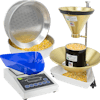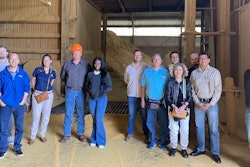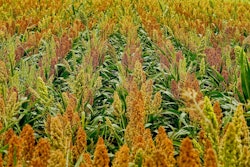
With the corn harvest rapidly approaching, growers and buyers everywhere are facing several challenges ranging from extreme weather to volatile market conditions.
TheU.S. Grains Council(USGC) has been conducting a series of events throughout the seasonas part of its missionto maintain strong relationships with international end users and boost exports on behalf of U.S. growers.
USGC’s awareness and servicing programs for foreign buyers become the most important during times such as this, ensuring that importers and other producers are aware of the quality and availability of U.S. corn to fight food insecurity and improve lives.
Central American buyers educated on U.S. grain export value chain
Local and regional regulations imposed by controlling and sanitary authorities in other countries can sometimes put a damper on exports. In the face of these challenges, taking a step back and being transparent about the U.S. trading system can often alleviate misunderstandings and help keep grains flowing into markets.
Take, for instance, Guatemala and Honduras. USGC recently hosted a team of government representatives from the two countries responsible for regulating grain imports with the goal of improving their knowledge of the U.S. export value chain. The team spent time in Illinois and Louisiana, experiencing the export system from start to finish.
“Knowing how the U.S. export value chain works is relevant for people directly involved in the importing process of feed grains, such as buyers and end-users, because it gives them a better grasp of what they should expect when buying from the U.S. in terms of logistics and controls at the origin,” says Ana Ballesteros, USGC marketing director for Latin America.
“That same understanding is equally relevant for those regulating imports at the destination countries. For representatives of the controlling authorities, seeing how things are done in the U.S. gives them tools to make decisions and define or modify regulations by considering the practices in the U.S. This knowledge usually ends up in facilitating trade.”
The team began in Illinois, visiting theIllinois Corn Growers’ Associationbefore stopping by a local grain inspection office. There, the team learned more about handling, analyzing and grading corn samples usingFederal Grains Inspection Service (FGIS)standards and procedures. Then, they moved to a corn farm and country elevator, where they learned about the production, storage and movement of corn in this initial stage of the export process.
During a visit to theIllinois Bureau of Weights and Measures, the group went to a grain moisture lab and a weight lab to better understand equipment certifications and fair transactions for the state’s farmers.
The final stop in the state was at a river barge terminal, where the team discovered how these terminals handle grain as it heads south to New Orleans for transport overseas.
“Seeing how the process begins, including visiting a corn farm, may seem like going too far back on the system. It is also showing how, regardless of the final destination of corn, the system is consistent,” Ballesteros said. “As one of our participants said following our final presentation, it may all begin with only a corn kernel, but an entire system has been built for it to feed the world.”
The trade mission continued in New Orleans later in the week, where the group saw live operations at the land-based and floating export elevators and bulk vessel and barge convoys transiting the river. Additionally, the team visited the New Orleans FGIS field office, this time learning about FGIS’s role in moving grain from the U.S. to destinations around the world.
The group also had the opportunity to observe three private laboratories to study the services and technology used by independent surveyors in the U.S. export industry. They then received a comprehensive presentation on the entire export system to wrap up the week of on-the-ground learning.
“The government officials were very engaged during our visits and asked many questions of our hosts. They expressed their gratitude for having the opportunity to learn and shared their admiration for how the U.S. system works, for its transparency and for the processes in place to guarantee a fair trade,” Ballesteros said. “We expect this experience will continue facilitating trade between the U.S. and these countries and, finally, help importers by supporting education.”
USGC will continue to work closely with its industry allies in Guatemala and Honduras, and other countries in the Latin American region, to identify practices that may be enhanced through a better comprehension of the U.S. feed grains supply system.
U.S. feed grains trusted by Canadians after drought
The USGC’s awareness efforts in the western hemisphere have also extended to the north this season following a drought last year that affected the western prairies of Canada.
The drought led to greater demand for imported feed, specifically a significant spike in U.S. corn and distiller’s dried grains with solubles (DDGS) entering the country.
Following these developments and to re-engage with participants in the Canadian market face-to-face for the first time since 2019, USGC staff spent time in Calgary and Lethbridge this summer, meeting with importers and end users of the two products.
The visit by USGC staff helped determine what additional support Canadian importers and end users may need as they continue to procure U.S. feed grains to meet their demand.
“This marketing year has seen record sales of U.S. corn and DDGS into Canada,” said Emily Byron, USGC director of global programs. “The USGC took this opportunity to meet with Canadian importers and end users to analyze the challenges that can come with increased imports and identify solutions to ensure a reliable supply of U.S. feed grains to our northern neighbor.”
在加拿大,拜伦和USGC加拿大顾问汤姆Dowler, had the opportunity to connect with grain brokers, merchandisers and swine and cattle producers to visit two trans-loading facilities in the process of unloading U.S. corn and DDGS.
The team also met with hog producers within the Hutterite community to continue conversations about the viability of U.S. feed grains in their swine rations.
“虽然最典型的阿尔伯塔省地区生产of its own feed grains, this past year’s severe drought left producers and end users with a smaller available supply. This market was very grateful for the strong partnership with the U.S. that allowed them to import U.S. corn and co-products,” Byron said. “We found that Canadian end users are comfortable using U.S. feed grains in their operations. Many end users have made or are looking to make investments in their operations with the idea that they will continue to use U.S. corn and DDGS in the future.”
U.S. feed corn quality touted to Japanese buyers
Meanwhile, on the other side of the globe, the USGC continues to build on over 50 years of collaboration and trust with Japanese buyers.
Since 1961, USGC’s work has contributed to the rapid growth of Japan’s feed and livestock industries, which have now made Japan the third largest importer of U.S. corn by bringing in over 10 million metric tons each year.
To increase Japanese importers’ confidence in the quality of U.S. corn, USGC’s Japan office recently hosted a corn quality information exchange for feed corn stakeholders in the country. This annual event has not occurred in person since 2019 due to the COVID-19 pandemic, and USGC hopes this year’s virtual format can reopen the door for the meeting to resume in its traditional form in the future.
“This annual meeting is important to maintain our close and mutually reliable relationship in corn trade and keep Japan as a stable buyer of U.S. corn,” said Tommy Hamamoto, USGC director in Japan.
美国组织的代表,包括USGCVice President Cary Sifferath, Hamamoto andNorth American Export Grains Association(NAEGA) President and CEO Gary Martin, in addition to several industry association representatives in Japan participated in the meeting at which attendees learned more about topics including the chemical and physical characteristics of recent U.S. corn, broken corn and foreign materials, and the weather’s impact and quality risk for this year’s crop.
“Through the meeting, both sides gained a better perspective of how this annual information exchange is an efficient venue for strengthening buyers’ understanding on U.S. corn quality concerns,” Hamamoto said.
Engaging in direct, consistent face-to-face dialogue with partners around the globe is a factor that cannot be understated when it comes to conducting business of any kind, and that certainly includes trade of agricultural products. It is the USGC’s mission to coordinate meetings and programs that support U.S. producers by developing new and existing markets for their goods, year after year.





















